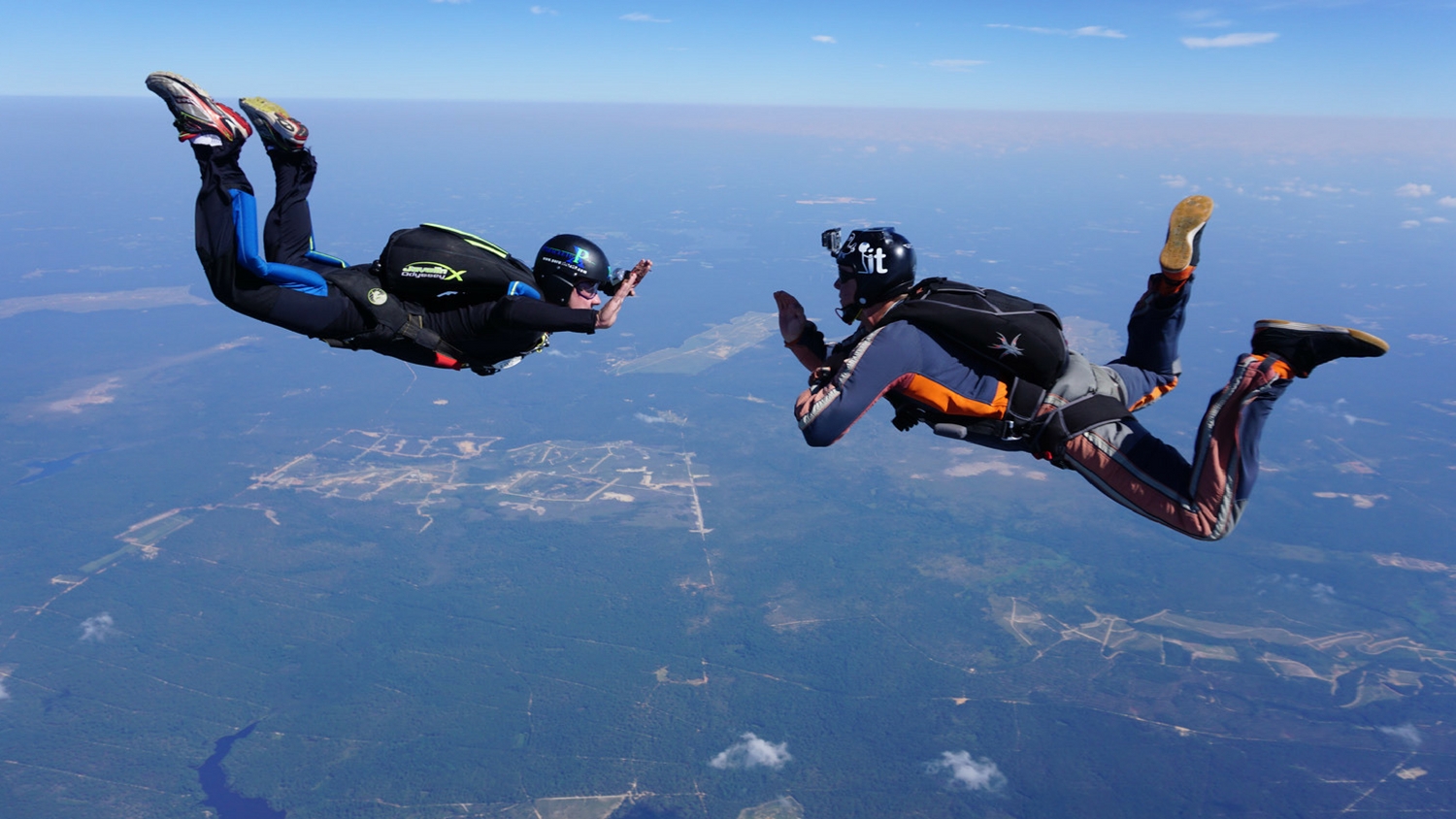

AUXILIARY PARACHUTE: Another term for the reserve or emergency parachute used on intentional jumps. AUDIBLE ALTIMETER: An alarm used by skydivers to alert them about reaching one or more pre-set altitudes. Seven cell canopies typically have an aspect ratio of about 2.2 to one, while nine cell canopies are usually between 2.8 and 3.0 to one. ASPECT RATIO: The ratio of a canopys width (side to side) to breadth (front to back). This usually includes two tandem jumps and an enhanced version of the AFF course. AS 8015A: Aerospace Standard 8015A defines the tests and minimum safety and performance standards which must be met for a parachute to receive approval under TSO C-23c. ARTISTIC EVENTS: Skydiving competition events that include freeflying, freestyle skydiving, and skysurfing. Described, it is hips forward with back arched legs extended to 45 degrees, toes pointed knees at shoulder width arms bent 90-120 degrees at the shoulders and elbows and relaxed head up. Position skydivers use to orient the front of their torso to the relative wind. Refers to a USPA Instructor or Instructor Examiner rated in the method-specific instructional discipline necessary to perform a particular task in accordance with the BSRs. Any alteration to an approved item will void the approval unless it is done in accordance with a specific alteration approval issued by the FAA. Approval may be in the form of a TSO, which is stamped on the article, by a military designation such as NAF, AAF or AN contract number, which is also stamped on the article, or by an STC or a Field Approval (Form 337). APPROVED: An item for which the FAA has issued approval documents. 
APPARENT WIND: The wind perceived by an observer.APA: Army Parachute Association, affiliated to the BPA, based at Netheravon.ANGLE OF INCIDENCE: The angle at which a canopy is trimmed to glide through the air.With square parachutes this changes when the brakes are applied. ANGLE OF ATTACK: The angle at which the wing is presented to the apparent wind.ALTIMETER: A device indicating altitude.

Any change or modification to any part of the parachute assembly from its original manufacturer. ALTERATIONS: Changes to the original configuration, such as removal of a gore, installation of an AAD or the addition of a deployment device.AIRSPEED: The speed of a flying object through the air, commonly used in reference to aircraft or canopies.AIRCRAFT: Any machine or device, including airplanes, helicopters, gliders, balloons, etc.Accuracy landings of various difficulty, from 20 meters to 2 meters, are required for USPA licenses. At the National level the target is 3 cm in diameter, about the size of a quarter. ACCURACY: Also known as Precision Landing, this is a competition discipline in which the skydiver attempts to land on an established target.ACCELERATED FREEFALL STUDENT: A skydiver trainee being trained by the Accelerated Freefall method who has not yet graduated from AFF Level 7.ACCELERATED FREEFALL SEMINAR: A gathering of USPA Accelerated Freefall rating holders to exchange, discuss and introduce new ideas to develop, improve or assure the quality of techniques and instruction used in the Accelerated Freefall method of instruction.
 ACCELERATED FREEFALL GRADUATE STUDENT: A novice skydiver who has successfully completed the training of the Accelerated Freefall method but has not yet obtained a USPA license. ACCELERATED FREEFALL CERTIFICATION COURSE AND TRAINING CAMP: A course registered with and authorized by USPA HQ to train, qualify and test candidates for Jumpmaster and Instructor ratings in the Accelerated Freefall method of student instruction. AFF-rated USPA Instructors accompany the student in freefall during the initial training jumps. ACCELERATED FREEFALL (AFF): USPA: Harness-hold freefall skydiving student training discipline developed under Ken Coleman and adopted by USPA.
ACCELERATED FREEFALL GRADUATE STUDENT: A novice skydiver who has successfully completed the training of the Accelerated Freefall method but has not yet obtained a USPA license. ACCELERATED FREEFALL CERTIFICATION COURSE AND TRAINING CAMP: A course registered with and authorized by USPA HQ to train, qualify and test candidates for Jumpmaster and Instructor ratings in the Accelerated Freefall method of student instruction. AFF-rated USPA Instructors accompany the student in freefall during the initial training jumps. ACCELERATED FREEFALL (AFF): USPA: Harness-hold freefall skydiving student training discipline developed under Ken Coleman and adopted by USPA. SKYDIVER FREEFALL LICENSE
Persons holding a USPA A License are able to jumpmaster themselves, perform basic relative work jumps, water jumps and pack their own main parachute. A LICENSE: The first level your USPA license which signifies that a skydiver has advanced beyond the novice phase.A device that senses rate of descent and altitude and which will attempts to mechanically activate the reserve parachute if the skydiver passes below a set altitude at a high rate of descent.








 0 kommentar(er)
0 kommentar(er)
